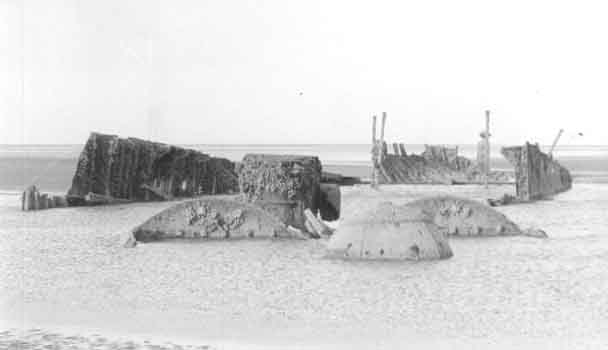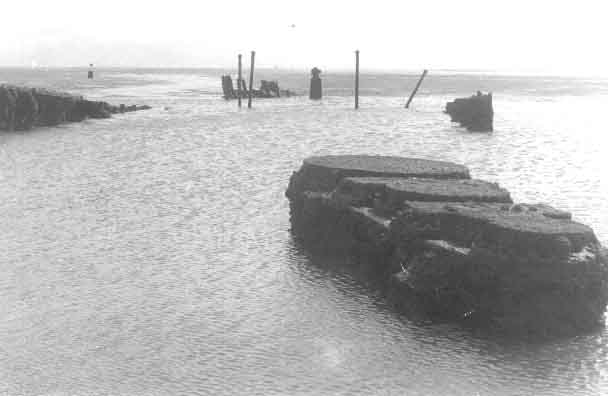
The Chrysopolis wreck photo taken in 1971
The Chrysopolis was outward bound from Genoa to Liverpool in Italy with a cargo of copper ore when she appeared to have run into a fog bank and become stranded on the Horsebank. The local records are limited and there are several theories as to what caused the stranding.
The Horsebank is an area of the Beach to the North of the Pier and at the time of the sinking would have been the last portion of the beach to be covered when the tide came in.
The area of Horsebank is moving all the time and it's current position is likely to be considerably different from it's position at the time of the disaster.
The Chrysopolis was 260' long 2931 tons a two masted steamer with holds fore and aft and a center bridge. Built for the Straights Steamship Co of Dover at the Irvine shipbuilding Co Westhartlepool and named "The Straights of Dover " she was later sold to the Greek flag and in 1916 requisitioned by the Italian goverment and leased to the Italian Railroad co. She had a 4 cylinder engine with twin boilers and a condensor all of which was visable in 1971.
She is still visible as I write this web page in August 2000 and although she has reduced considerable since my first visit in the late 1960's, she is likely to around for some time yet. She is located 2 1/2 miles off the pleasure beach and although it is possible to visit the remains this must be done with an experienced guide familier with the Southport beach.
The following is an extract from a doc in the Botanic Garden Museum
:- According to Mr Richard Aughton of Lytham Road who himself was an apprentice Boat builder in his earlier days and can remember the Chrysopolis incident in 1918 says that two tugs came to help tow the Chrysopolis off the Spencers bank one came from Liverpool and the other the Flying Cock came down from Preston. When the stranded vessel which had been well and truly repaired started her engine both tugs took hold of her with there toeing hausers and took the strain After moving slowly for about 1000 yds she grounded again on a slightly higher portion of the beach. It would seem that with the tugs going all out to tow her off and the thrust by her own propeller caused her to break her back although Mr Aughton says the Tugs were not pulling simultaneously - this would seem unusual - but we must accept the fact that probably some of the underside plates must )have been under severe strain at times whiist lying on the sand.
 Extracts from the lifeboat mins -:
Extracts from the lifeboat mins -:
Report for the year 1917 During the year under review there was no call for the services of the Lifeboat, but on the morning of the 21st of Feb last signals of distress were observed from a large Italian steamer, the Chrysopolis which had stranded on the Horse bank about two miles to the west of the pier a week previously during fine weather Salvage operations were in progress, but during the night of the 20 ,Feb a moderate westerly gale sprang up and the vessel filled, placing the crew in a position or serious danger at high water. The Lifeboat left her moorings at about 8.15 am and on reaching the vessel successfully took oft the entire crew of 38 handfand also four other men who had been sent aboard by the Salvage association arriving hack at the Pier about 9.10 a.m. This constitutes a record for the station in the number of lives saved on any one service.
